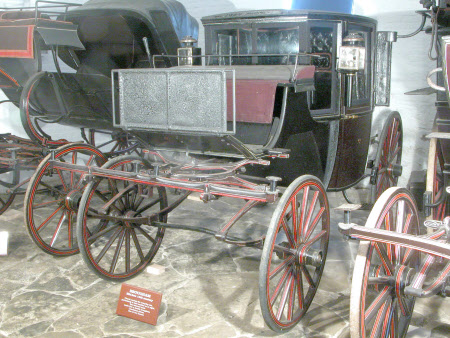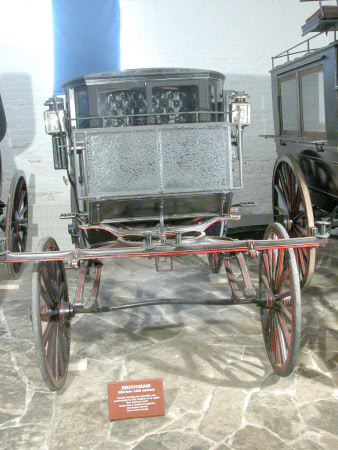Brougham
Windovers Ltd
Category
Carriages & other vehicles
Date
circa 1880 - 1880
Materials
Painted wood body with wool cloth and morocco leather upholstery and four iron shod wheels.
Measurements
355.5 x 166.5 x 205.5cm (11ft 8in x 5ft 51/2in x 6ft 9in)
Place of origin
London
Order this imageCollection
Charlecote Park, Warwickshire
NT 534202
Caption
The brougham was a popular gentleman's carriage for travelling around town. This example is a double brougham meaning that it has seating for two, with a fold down seat at the front inside the carriage, and pulled by a pair of horses. A single brougham only has seating for one and is very often light enough to be pulled by one horse. Built by Windovers of London, one of the premier coachbuilders of the time, circa 1880. This double brougham is painted black and dark brown with red and white lining, a colour scheme that seems to have been favoured by the Lucy family.
Summary
Double Brougham built by Windovers of London for the Lucy family circa 1880. Double brougham (four wheels) for a pair of horses. The body is of angular profile suspended on on elliptic springs front and back. The interior is trimmed with black and burgundy buttoned leather, burgundy wool cloth with broad laces [red with striped border] and other laces to match. The body is painted black with fine red and white lining. The under carriage is dark brown with fine white lining.
Full description
A good double Brougham with angular profile, by a premier builder. Windovers were a well-known and highly respected firm established in 1857 in Long Acre. They remained in business until the 1930's. The first brougham was commissioned in 1837 by Henry Peter Brougham (1778-1868) first Baron Brougham and Vaux, Whig politician, lawyer and Minister of State. He wanted “a refined and glorified street cab, which would make a convenient carriage for a gentleman”, unlike his usual form of transport, probably a town coach or chariot, both far larger and heavier. He designed a carriage that would be light and compact, needing just one horse and a coachman – ideal for use on busy streets. The body would be low for easy access and should carry two people and be “closed and intimate thus allowing the occupants to conduct a private conversation whilst travelling”. His ideas were rejected by his usual coachbuilder so he took them to another, Robinson & Cook, just round the corner. They agreed to build the vehicle and it was called the Brougham by his Lordship’s express permission. Lord Brougham’s brainchild was an instant success and, within a few years, broughams were being built in vast numbers wherever carriages of Western European style were used. They were particularly popular with professional and middle class families, and became the everyday carriages of the wealthy and the aristocracy.
Provenance
Given to the National Trust in 1945.
Marks and inscriptions
On the nearside door panel. : Crest On the offside door panel.: Crest On the front nearside axle cap.: Windovers On the front offside axle cap.: Windovers On the rear nearside axle cap.: Windovers On the rear offside axle cap.: Windovers
Makers and roles
Windovers Ltd, coach builder
References
Carriage Driving, Oct-Nov 1997, page 21

